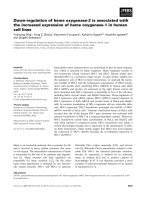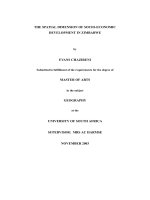THE APPLIED RESEARCH OF FRICTION WELDING TECHNIQUE IN NHA TRANG UNIVERSITY
Bạn đang xem bản rút gọn của tài liệu. Xem và tải ngay bản đầy đủ của tài liệu tại đây (524.16 KB, 5 trang )
Kỷ yếu hội nghị khoa học và công nghệ toàn quốc về cơ khí - Lần thứ IV
THE APPLIED RESEARCH OF FRICTION WELDING TECHNIQUE
IN NHA TRANG UNIVERSITY
NGHIÊN CỨU ỨNG DỤNG KỸ THUẬT HÀN MA SÁT
TẠI ĐẠI HỌC NHA TRANG
Hưng Trà, 2bOkazaki
1
Nha Trang University, Vietnam
2
Nagaoka University of Technology, Japan
a
;
1aTrần
ABSTRACT
In this paper, some new results in the friction welding research developed in Nha Trang
University are presented. The friction technique is quite suitable for joining alumunim alloys
and superalloys. This technique is recognized to be suitable for joining the unweldable metals
and dissimilar joining. The joints posses several preeminent points such as low distortion, low
residual stress, free defects, and high strength. Furthermore, this welding technique is a green
technique, it is performed without gas and low energy.
Keywords: friction welding, aluminum alloys, superalloys, microstructure, strength.
TÓM TẮT
Bài báo sẽ trình bày những kết quả đạt được trong nghiên cứu ứng dụng kỹ thuật hàn
ma sát tại Đại học Nha Trang. Kỹ thuật hàn ma sát cho thấy nhiều tính năng ưu việt, cho phép
hàn được hầu hết các hợp kim nhôm và các siêu hợp kim dễ dàng, đặc biệt hàn được cả các
hợp kim khó tính và hàn giữa các hợp kim khác nhau. Chất lượng mối hàn đảm bảo không
khuyết tật, ít biến dạng, ứng suất dư thấp và độ bền cao. Ngoài ra, công nghệ hàn này được
xem là công nghệ xanh, thân thiện với môi trường, không dùng gas và chi phí năng lượng hàn
thấp.
Từ khóa: hàn ma sát, hợp kim nhôm, siêu hợp kim, cấu trúc tế vi, độ bền.
1. INTRODUCTION
Emerging as a high energy efficiency and versatility, friction welding (FW) has been
found to be a key technique in metal joining. This technique is suitable for all alloys including
the alloys recognized to be unweldable by traditional fusion welding methods. Currently, FW
is being studied and applied in a wide range of applications in which the welding can be
obtained with high strength and low distortion [1-7]. Especial in the aerospace industry, where
the high specific strength becomes a critical issue [5-7]. The economic efficiency concerning
to light structure is presented in Figure 1.
Even thought FW possesses several preeminent points, this technique is applied
restrictively in Vietnam. Only a few places address to this topic. In order to develop this
friction technique, we establish a Friction welding Laboratory in Nha Trang University. Here,
currently, several joints of alloys are fabricated by both friction welding technique and
friction stir welding technique. It is recognized that the joints are fabricated easily with free
defects and high strength. We hope, in the future, more and more connections between us and
other researchers and/or manufacturers to develop this technique in Vietnam.
414
Kỷ yếu hội nghị khoa học và công nghệ toàn quốc về cơ khí - Lần thứ IV
Figure 1: Money savings per pound of the lighter structure [8]
2. RESEARCH METHODS AND MATERIALS
The friction joints have been studied and fabricated by using the friction welding
machine at Nha Trang Univiversity (denoted NTU FW machine) with the spindle power of
6.0 kW, vertical linear movement of 18.0 kN loading capacity and horizontal linear
movement of 20.0 kN loading capacity. In this work, two types of friction welding are applied
in which one is friction stir welding and the other is rotated friction welding. In the friction
stir process, two aluminum alloy plates is welded by both similar and dissimilar alloys joining
(fabricated for 3 typical types of aluminum alloys: 5xxx, 6xxx, and 7xxx). In the rotation
friction process, the joints of the high strength alloys is addressed.
3. RESULTS AND DISCUSSION
3.1. Friction stir processing
Several types of welded joints are fabricated by the friction process. In figure 2 shows
the friction stir welded joint of two AA5083 bars. The tensile strength of the joint is obtained
above 90% of that of base metal.
In Figure 3, the lap joints of two AA6061 plates are fabricated by the friction stir
process. The microstructure of the joint is polished and observed and it is found that the joint
is defect free with the tensile strength of the joint reaches to above 75% of that of base metal.
In Figure 4, the lap joint of two AA7075 plates with thickness of 8.0 mm and length of
1200 mm are fabricated by the friction stir process. The microstructure of the joint is polished
and observed and it is found that the joint is defect free with the tensile strength of the joint
reaches to above 77% of that of base metal.
In Figure 5 shows the result of dissimilar joint between AA5083 and AA6061, the joint
is free defects with tensile strength obtains above 73% of base metal AA6061.
The dissimilar T-joint is also conducted on this FW machine. This T-joint is fabricated
between AA7075 and AA5083, Figure 6. It is found that, the joint shows a good quality in
both the macro and micro view. The tensile strength of the joint is being investigated and will
be opened soon.
The cross section microstructure of the FSW joint can be seen in Figure 7, where the
joint is perfectly with free defects.
415
Kỷ yếu hội nghị khoa học và công nghệ toàn quốc về cơ khí - Lần thứ IV
Figure 3: Friction stir welding of AA6061
plates by using NTU FW machine
Figure 2: Friction stir welding of AA5083
bars by using NTU FW machine
Figure 4: Friction stir welding of 7075 plates by using NTU FW machine
(Welding length of 1.2 m)
Figure 5: Dissimilar friction stir welding of AA5083 and AA6061 plates by using NTU
FW machine
Figure 6: Disimilar T-joint friction stir welding of AA5083 and AA7075
(Using NTU FW machine)
416
Kỷ yếu hội nghị khoa học và công nghệ toàn quốc về cơ khí - Lần thứ IV
Figure 7: Microstructure in cross section of FSW of AA6063 (a) region (i), (b) region (ii),
(c) region (iii) and (d) base metal region
3.2. Rotated friction processing
The dissimilar friction joint of two superalloys is fabricated. This joint requires a large
power and thus we conducted this work in Hitachi Co. In this work, the superalloy Inconel
718 and Mar M247 are joined. Here, the joint possesses a create quality with free defects and
high strength, see figure 10. The tensile strength of the joint is equivalent to the base metals.
Further, the fatigue life of the joint is comparable to that of base metal [4].
Figure 8: Cross section at the interface of the totation friction welding of superally
Inconel 718 and Mar M247 (Fabricated in Hitachi Co.)
417
Kỷ yếu hội nghị khoa học và công nghệ toàn quốc về cơ khí - Lần thứ IV
CONCLUSIONS
It is well known that aluminum alloys and superalloys as well are difficult to weld,
especially in the dissimilar welding. However, these alloys are fabricated successfully by the
friction processing with free defects and high strength in Nha Trang University. The friction
technique promises several chances for not only joining alloys, but also for fabricating the
composite components. Further, this technique is possible for us to use in crack repair and
local microstructure modifications.
REFERENCES
[1] E. D. Nicholas, Friction processing technologies, Welding in The World 2003,
47(11/12), pp. 2-9.
[2] Tran Hung Tra, Desertation: Failure behaviors of the solid-state friction-welded joints
under cyclic loadings at elevated temperatures, Nagaoka Univ. of Tech., 2010.
[3] Tran Hung Tra, M. Okazaki, M. Sakaguchi, K. Suzuki, Fatigue crack propagation
behavior of friction stir welding AA 6063-T5: Residual stress and microstructure
effect, International Journal of Fatigue, 2012, Vol. 43, pp. 23-29.
[4] Tran Hung Tra, Effect of weld parameters on the mechanical properties of friction stir
welding AA6063-T5, ASEAN Engineering Journal, 2011, Vol 4, pp. 73-81.
[5] M. Okazaki, M. Sakaguchi, T. H. Tran, M. Sekihara, Creep-fatigue and thermomechanical fatigue of friction-welded IN718/MarM247 dissimilar joint, Superalloys
2008, pp. 221-228.
[6] U. Dressler, G. Biallas, U. Alfaro Mercado, Friction stir welding of titanium alloy
TiAl6V4 to aluminium alloy AA2024-T3, Materials Science and Engineering A 2009,
256(1-2), pp. 113-117.
[7] F. Daus, H. Y. Li, G. Baxter, S. Bray, P. Bowen, Mechanical and microstructural
assessments of RR1000 to IN718 inertia welds - effects of welding parameters, Mater Sci
Tech 2007, 23(12), pp. 1424-1432.
[8] P. F. Mendez, T. W. Eagar, New trends in welding in the aeronautic industry:
2006.
AUTHOR’S INFORMATION
1.
Tran Hung Tra. Nha Trang University. Email: Phone: 0935272168
2.
Okazaki, Nagaoka University of Technology, Email:
418









